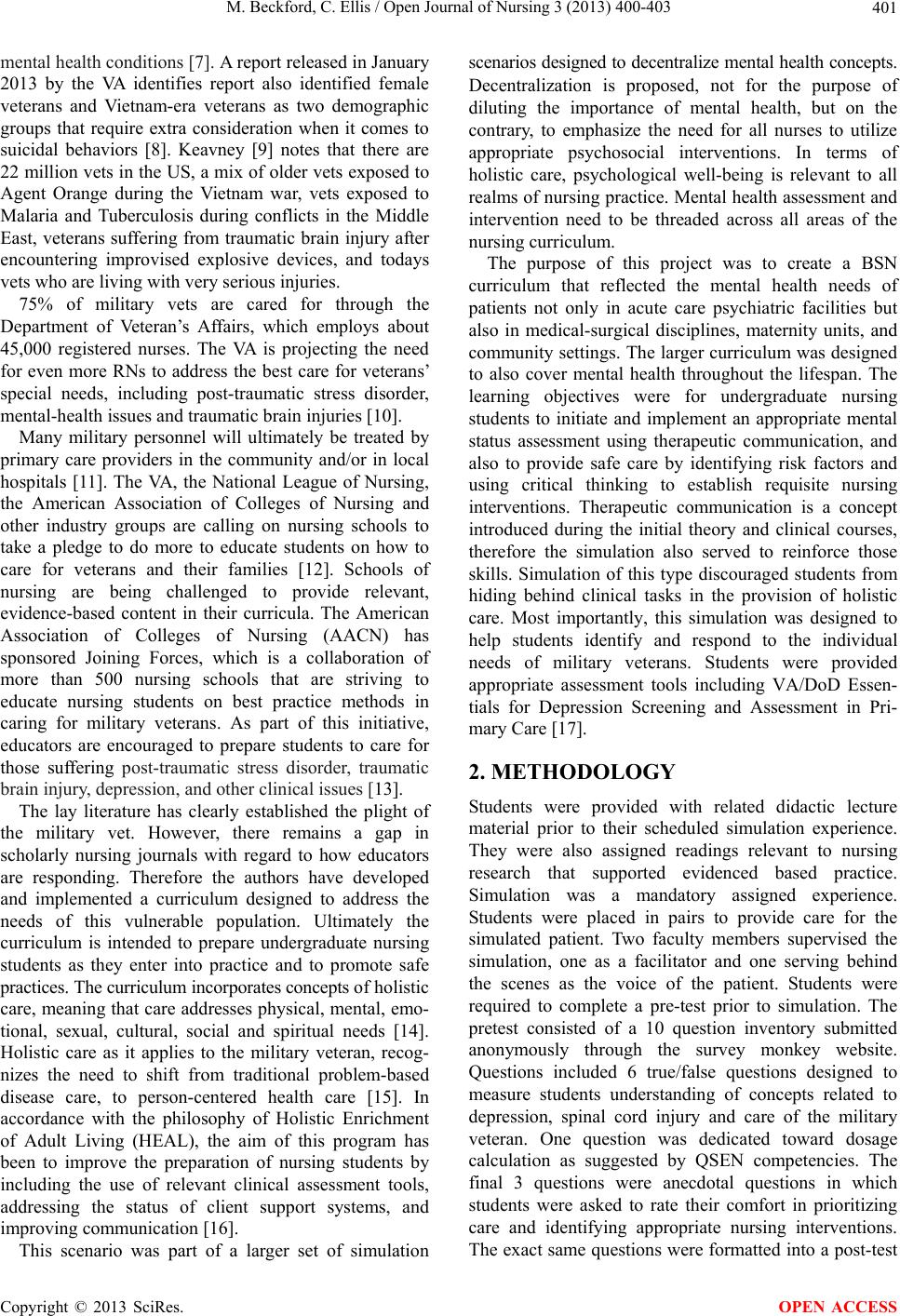
M. Beckford, C. Ellis / Open Journal of Nursing 3 (2013) 400-403 401
mental health cond itions [7 ]. A report released in January
2013 by the VA identifies report also identified female
veterans and Vietnam-era veterans as two demographic
groups that require extra consideration when it comes to
suicidal behaviors [8]. Keavney [9] notes that there are
22 million vets in the US, a mix of older vets exposed to
Agent Orange during the Vietnam war, vets exposed to
Malaria and Tuberculosis during conflicts in the Middle
East, veterans suffering from traumatic brain injury after
encountering improvised explosive devices, and todays
vets who are living with very serious injuries.
75% of military vets are cared for through the
Department of Veteran’s Affairs, which employs about
45,000 registered nurses. The VA is projecting the need
for even more RNs to address the best care for veterans’
special needs, including post-traumatic stress disorder,
mental-health issues and traumatic brain injuries [10].
Many military personnel will ultimately be treated by
primary care providers in the community and/or in local
hospitals [11]. The VA, the National League of Nursing,
the American Association of Colleges of Nursing and
other industry groups are calling on nursing schools to
take a pledge to do more to educate students on how to
care for veterans and their families [12]. Schools of
nursing are being challenged to provide relevant,
evidence-based content in their curricula. The American
Association of Colleges of Nursing (AACN) has
sponsored Joining Forces, which is a collaboration of
more than 500 nursing schools that are striving to
educate nursing students on best practice methods in
caring for military veterans. As part of this initiative,
educators are encouraged to prepare students to care for
those suffering post-traumatic stress disorder, traumatic
brain injury, depression, and other clinical issues [13].
The lay literature has clearly established the plight of
the military vet. However, there remains a gap in
scholarly nursing journals with regard to how educators
are responding. Therefore the authors have developed
and implemented a curriculum designed to address the
needs of this vulnerable population. Ultimately the
curriculum is intended to prepare undergraduate nursing
students as they enter into practice and to promote safe
practices. The curriculum incor porates concepts of holistic
care, meaning that care addresses physical, mental, emo-
tional, sexual, cultural, social and spiritual needs [14].
Holistic care as it applies to the military veteran, recog-
nizes the need to shift from traditional problem-based
disease care, to person-centered health care [15]. In
accordance with the philosophy of Holistic Enrichment
of Adult Living (HEAL), the aim of this program has
been to improve the preparation of nursing students by
including the use of relevant clinical assessment tools,
addressing the status of client support systems, and
improving communication [16].
This scenario was part of a larger set of simulation
scenarios designed to decentralize mental health concepts.
Decentralization is proposed, not for the purpose of
diluting the importance of mental health, but on the
contrary, to emphasize the need for all nurses to utilize
appropriate psychosocial interventions. In terms of
holistic care, psychological well-being is relevant to all
realms of nursing practice. Mental health assessment and
intervention need to be threaded across all areas of the
nursing curriculum.
The purpose of this project was to create a BSN
curriculum that reflected the mental health needs of
patients not only in acute care psychiatric facilities but
also in medical-surgical disciplines, maternity units, and
community settings. The larger curricu lum was designed
to also cover mental health throughout the lifespan. The
learning objectives were for undergraduate nursing
students to initiate and implement an appropriate mental
status assessment using therapeutic communication, and
also to provide safe care by identifying risk factors and
using critical thinking to establish requisite nursing
interventions. Therapeutic communication is a concept
introduced during the initial theory and clinical courses,
therefore the simulation also served to reinforce those
skills. Simulation of this type discouraged students from
hiding behind clinical tasks in the provision of holistic
care. Most importantly, this simulation was designed to
help students identify and respond to the individual
needs of military veterans. Students were provided
appropriate assessment tools including VA/DoD Essen-
tials for Depression Screening and Assessment in Pri-
mary Care [17].
2. METHODOLOGY
Students were provided with related didactic lecture
material prior to their scheduled simulation experience.
They were also assigned readings relevant to nursing
research that supported evidenced based practice.
Simulation was a mandatory assigned experience.
Students were placed in pairs to provide care for the
simulated patient. Two faculty members supervised the
simulation, one as a facilitator and one serving behind
the scenes as the voice of the patient. Students were
required to complete a pre-test prior to simulation. The
pretest consisted of a 10 question inventory submitted
anonymously through the survey monkey website.
Questions included 6 true/false questions designed to
measure students understanding of concepts related to
depression, spinal cord injury and care of the military
veteran. One question was dedicated toward dosage
calculation as suggested by QSEN competencies. The
final 3 questions were anecdotal questions in which
students were asked to rate their comfort in prioritizing
care and identifying appropriate nursing interventions.
The exact same questions were formatted into a post-test
Copyright © 2013 SciRes. OPEN ACCESS